During my trip to Tuguegarao City last summer, I discovered the most amazing noodle dish I've ever tasted - Pancit Batil Patung.
While looking for somewhere to eat lunch, a friendly local pointed me to a small eatery where I watched the cook make this special pancit. The way they prepared it was different from any pancit I'd had before: mixing fresh noodles with tender meat, topping it with a runny egg, and serving it with a hot soup on the side.
After chatting with the cook and visiting the shop several times, I learned how to make it at home. Now I'm excited to share this recipe with you. While it might look fancy, don't worry - if you can cook regular pancit, you can definitely make this Tuguegarao specialty in your own kitchen.
Jump to:
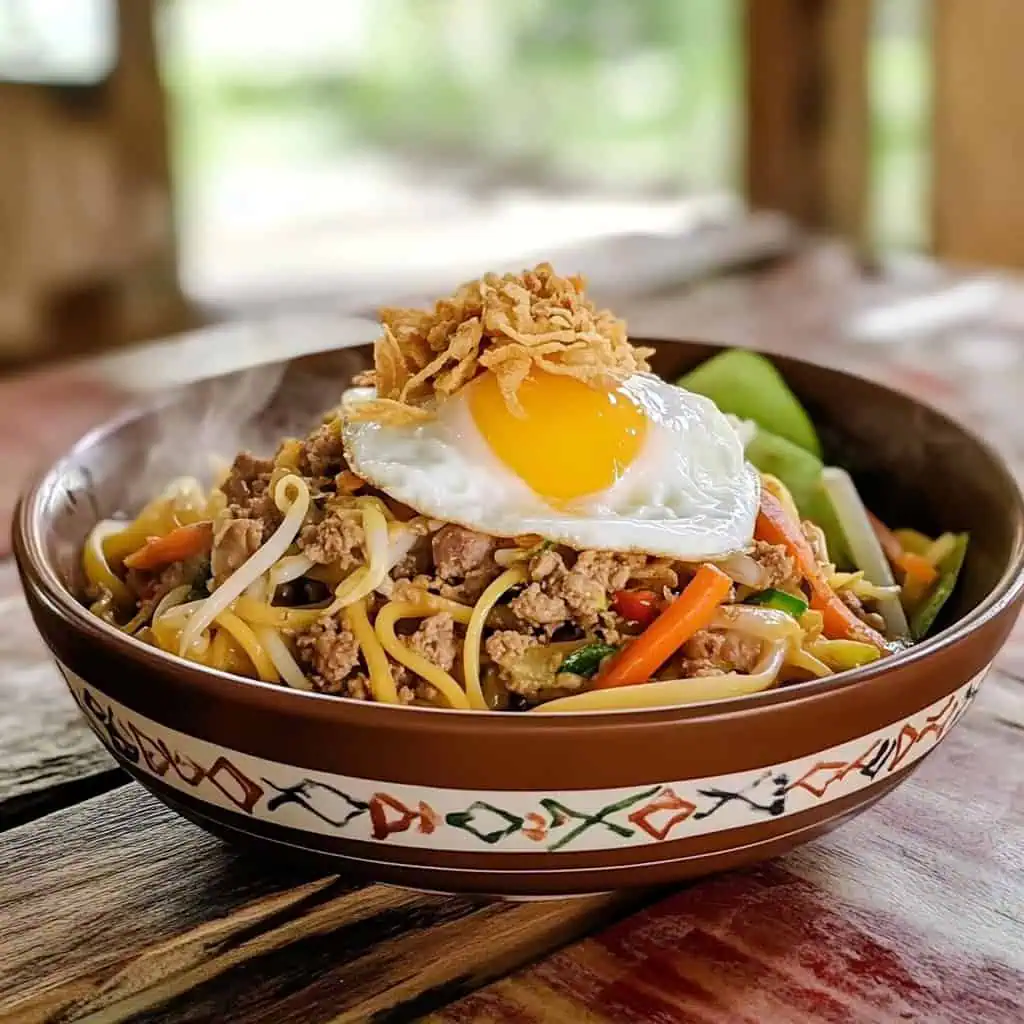
Why You'll Love This Recipe
- Authentic Tuguegarao flavors that transport you to the streets of Cagayan Valley
- Perfect balance of textures: chewy noodles, tender meat, crispy chicharon, and silky egg
- Customizable toppings to suit your taste
- Complete meal in one bowl with protein, vegetables, and carbohydrates
- Rich in Filipino culinary heritage
- Impressive dish for special occasions
Ingredients
Each component in Pancit Batil Patung serves a specific purpose. The fresh miki noodles provide the hearty base and chewy texture that distinguishes this dish from other pancit varieties.
Carabao meat and pork belly deliver rich, complementary flavors and tender protein. The vegetables add necessary freshness and crunch, while chicharon contributes that irresistible crispy texture. The poached egg creates a silky sauce when mixed with the noodles, and the separate soup enhances every bite with warmth and depth.
This careful balance of ingredients creates a truly complete meal in a single dish.

For the Noodles and Meat:
- 500g fresh Miki or Hokkien noodles
- 200g pork belly, sliced into small pieces
- 200g carabao beef, minced (or ground beef as alternative)
- 2 cups crushed chicharon (pork rinds)
- 8 cloves garlic, minced
- 1 medium onion, sliced
- ½ cup soy sauce
- 2 tablespoons fish sauce (patis)
- Cooking oil
- Freshly ground black pepper
For the Vegetables:
- ¼ head cabbage, shredded
- 1 cup bean sprouts (togue)
- 1 medium carrot, julienned
- 3 stalks green onions, chopped
For the Soup:
- 3-4 cups carabeef and pork stock
- 2 eggs, beaten
- Salt and pepper to taste
For Garnish:
- 4-6 poached eggs
- Calamansi, sliced
- Additional crushed chicharon
- Chopped green onions
Equipment
- Large wok or deep pan: Essential for stir-frying noodles and developing proper "wok hei" (breath of the wok) - this high-heat cooking method creates the dish's distinctive smoky flavor
- Sharp chef's knife: For precise cutting of meat and vegetables, ensuring even cooking and proper texture
- Wooden spatula: Allows gentle stirring without breaking the delicate noodles
- Strainer: Used for draining noodles and blanching vegetables to the perfect texture
- Small pot: For preparing the accompanying soup
- Whisk: Creates silky egg strands in the soup
- Serving bowls: One large bowl for the main dish and smaller bowls for the soup

How To Make
- Prepare ingredients: Gather all ingredients and prepare them as indicated above.
- Make the broth: In a pot, simmer pork bones and carabao meat trimmings in water over medium heat (180°C) for 30 minutes. Strain and set aside.
- Cook the meat: Heat 3 tablespoons oil in a large wok over medium heat. Cook minced carabao beef until brown (about 5 minutes). Remove and set aside. In the same pan, cook pork belly pieces until golden brown (about 5 minutes), then push to one side.
- Start the noodle base: Add half the garlic and onions to the empty side of the pan. Sauté until fragrant and translucent (about 1 minute).
- Cook the noodles: Add fresh miki noodles to the pan. Pour in 1 cup of broth, ½ cup soy sauce, and 2 tablespoons fish sauce. Stir gently while gradually adding more broth for about 5 minutes until noodles are cooked but still chewy.
- Add first vegetables: Incorporate bean sprouts with a quick stir. Transfer everything to your serving bowl.
- Cook remaining vegetables: In the same pan, add a little more oil if needed. Sauté remaining garlic and onions for 1 minute. Add carrots and cook for 2 minutes. Add cabbage and cook for 2 more minutes. Season with a splash of fish sauce and some pepper.
- Assemble the dish: Layer cooked vegetables over the noodles in the serving bowl. Top with cooked carabao meat.
- Prepare the soup: Heat remaining broth until hot but not boiling. While stirring continuously, slowly pour in beaten eggs to create silky strands. Season with salt and pepper.
- Add the signature egg: Cook one egg (poached or sunny side up) for each serving. Place on top of each bowl.
- Final touches: Sprinkle generously with crushed chicharon and chopped green onions.
- Serve: Pour hot soup into small serving bowls. Serve alongside the noodle bowls with sliced calamansi.
- Eating instructions: Squeeze calamansi over noodles and mix everything together. Sip the hot soup between bites, adding more chicharon as desired for extra crunch.

Tips from Lola's Kitchen
- Use fresh miki noodles whenever possible for authentic texture. The difference is remarkable!
- Prepare extra broth - people often want more of the delicious soup
- Cook noodles al dente (slightly firm) as they will continue absorbing liquid
- Don't overcook vegetables - they should retain some crispness
- Beat eggs thoroughly before adding to soup for those beautiful silky strands
- Keep chicharon separate until serving to maintain its crunch
- Serve immediately after assembly for the best texture and temperature contrast
Substitutions
- Carabao meat: Substitute with beef or pork if unavailable
- Fresh miki noodles: Use thick yellow egg noodles or lo mein noodles
- Chicharon: Crispy fried garlic or crispy fried shallots can provide crunch
- Fish sauce: Add extra soy sauce or a dash of salt
- Calamansi: Lemon or lime can provide similar acidity
- Pork belly: Use chicken thigh meat or beef sirloin cut into strips
- Bean sprouts: Substitute with julienned snow peas or additional cabbage
Troubleshooting
- Noodles too dry: Add more stock gradually while stirring gently
- Noodles too soggy: Cook them less next time; drain better before saucing
- Soup too thick: Add hot water or additional stock
- Vegetables too soft: Reduce cooking time; add them later in the process
- Egg not forming silky strands in soup: Ensure broth isn't boiling; beat eggs more thoroughly; stir continuously while pouring
- Flavors too mild: Add a bit more fish sauce or soy sauce; finish with a dash of sesame oil
- Not enough crunch: Add more fresh chicharon right before serving
Storage & Reheating
- Store components separately: Keep noodles, soup, and toppings in different containers
- Refrigeration: Will keep for up to 2 days in airtight containers
- Noodle reheating: Warm in a pan with a splash of water or broth to restore moisture
- Soup reheating: Heat gently on stovetop until just hot; don't boil aggressively
- Fresh elements: Consider preparing fresh eggs and adding fresh chicharon when serving leftovers
- Not recommended for freezing: The texture of noodles and vegetables will deteriorate
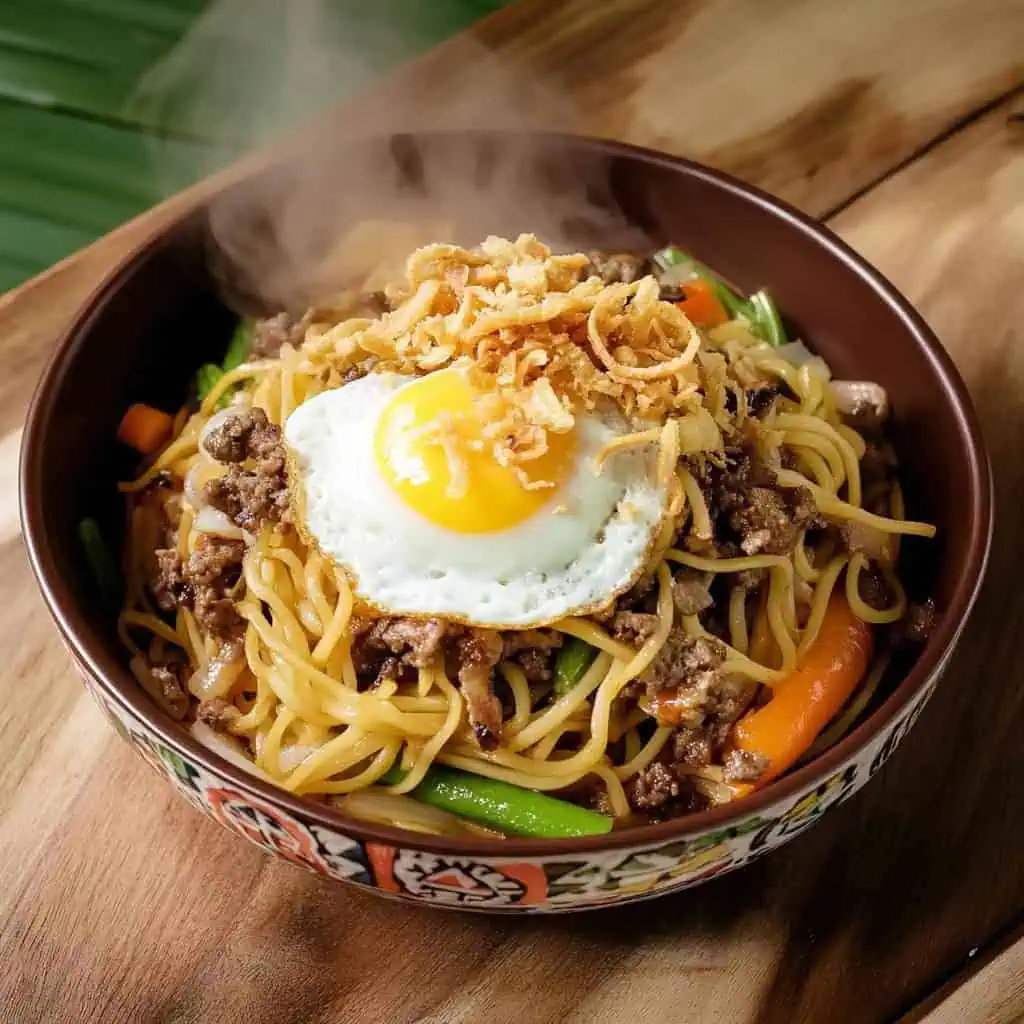
FAQ
Can I prepare components of this dish in advance?
Yes! Make the broth and cook the meats a day ahead. Store refrigerated and assemble fresh before serving.
What makes authentic Pancit Batil Patung different from other pancit dishes?
Three key elements: the use of carabao meat, the egg placed on top, and the distinctive soup served on the side.
Is this dish spicy?
Traditional Pancit Batil Patung isn't spicy, but you can add chili sauce or fresh chilies to taste.
How do I know when the noodles are properly cooked?
They should be chewy but not mushy - similar to al dente pasta. They'll continue absorbing liquid after cooking.
Can I make a healthier version?
Absolutely! Use leaner meat cuts, reduce oil, increase vegetables, and use less chicharon.
What's the best way to eat Pancit Batil Patung?
Mix the egg on top into the noodles, add chicharon for crunch, squeeze calamansi over everything, and sip the soup between bites of noodles.
Can I use different vegetables?
While traditional vegetables create the authentic experience, feel free to include bell peppers, broccoli, or other vegetables you enjoy.
Where does the name come from?
"Batil" refers to the beaten egg in the soup, while "patung" means "to place on top," referring to the egg crown on the noodles.
Related
Looking for other recipes like this? Try these:
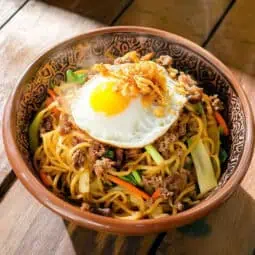
Pancit Batil Patung (Tuguegarao-Style Noodles)
Equipment
- Large wok or deep pan (kawa) for stir-frying noodles and achieving proper "wok hei"
- Sharp knife (kutsilyo) for precise meat and vegetable cutting
- Wooden spatula (sandok na kahoy) for stirring without breaking the noodles
- Strainer [Salaan] for draining noodles and blanching vegetables
- Small pot for preparing the soup
- Egg whisk (panghalo ng itlog) for beating eggs for the soup
- Serving bowls (mangkok) for the main dish and soup
Ingredients
For the Noodles and Meat
- 500 g Fresh Miki or Hokkien noodles Mikining Tuguegarao
- 200 g pork belly sliced into small pieces (liempo)
- 200 g carabao beef minced (giniling na kalabaw)
- Alternative: ground beef giniling na baka
- 2 cups crushed chicharon crushed pork rinds
- 8 cloves garlic minced (bawang)
- 1 medium onion sliced (sibuyas)
- ½ cup soy sauce toyo
- 2 tablespoons patis fish sauce
- Cooking oil mantika
- Freshly ground black pepper paminta
For the Vegetables
- ¼ head cabbage shredded (repolyo)
- 1 cup togue bean sprouts
- 1 medium carrot julienned (karot)
- 3 stalks green onions chopped (sibuyas na mura)
For the Soup
- 3-4 cups carabeef and pork stock
- 2 eggs beaten
- Salt and pepper to taste asin at paminta
For Garnish
- 4-6 poached eggs it;log
- Calamansi sliced
- Additional crushed chicharon
- Chopped green onions
Instructions
- Take out your fresh miki noodles (500g), sliced pork belly (200g), minced carabao beef (200g), crushed chicharon (2 cups), shredded cabbage (¼ head), bean sprouts (1 cup), julienned carrots (1 medium), sliced onion (1 medium), and minced garlic (8 cloves). You'll also need soy sauce, fish sauce, black pepper, eggs, cooking oil, and calamansi.
- Start by making your broth. Fill a pot with water and add some pork bones and carabao meat trimmings. Let this simmer on medium heat (180°C) for 30 minutes. Once done, strain the broth and set it aside.
- Heat up your large pan or wok over medium heat. Add 3 tablespoons of oil. Once hot, cook your minced carabao beef until brown. This takes about 5 minutes. Take it out and set aside.
- In the same pan, cook your pork belly pieces until they turn golden brown, about 5 minutes. Move them to one side of the pan.
- Add half of your garlic and onions to the empty side of the pan. Cook until they smell fragrant and the onions become clear, about 1 minute.
- Now add your fresh miki noodles. Pour in 1 cup of your broth, then add ½ cup soy sauce and 2 tablespoons fish sauce.
- Keep stirring the noodles gently while adding more broth little by little. Do this for about 5 minutes until the noodles are cooked but still chewy.
- Add your bean sprouts and give everything a quick stir. Transfer all of this to your serving bowl.
- Using the same pan, add a little more oil if needed. Cook your remaining garlic and onions for 1 minute. Add your carrots and cook for 2 minutes. Then add your cabbage and cook for 2 more minutes. Season with a splash of fish sauce and some pepper.
- Put all your cooked vegetables on top of your noodles in the serving bowl. Add your cooked carabao meat on top of the vegetables.
- For the soup, heat up your remaining broth until it's hot but not boiling. Beat an egg in a small bowl. While stirring the broth, slowly pour in the beaten egg. Add some salt and pepper to taste.
- Cook one egg (either poached or sunny side up) for each bowl of noodles you're serving. Place this egg on top of each bowl.
- Sprinkle plenty of crushed chicharon over everything. Add some chopped green onions if you like.
- Pour your hot soup into small serving bowls. Place these next to your noodle bowls along with some sliced calamansi.
- When eating, squeeze some calamansi over your noodles and mix everything together. Sip the hot soup between bites. Add more chicharon as you eat if you want extra crunch.
- Make sure to serve everything while hot. The vegetables should still be a bit crispy, and the egg yolk should be runny so it mixes nicely with the noodles.
Tips from Lola's Kitchen
- Use fresh miki noodles for authentic texture
- Don't overcook the vegetables to maintain crunch
- Beat the egg well before adding to the soup for silky strands
- Always serve the soup piping hot
- Prepare extra crushed chicharon for guests to add as needed
Nutrition
The Story Behind Pancit Batil Patung
Deep in the heart of Cagayan Valley, Tuguegarao City is home to one of the Philippines' most unique noodle dishes - Pancit Batil Patung. The name itself tells us how to eat it: "batil" means to beat (as in beating an egg), and "patung" means to put on top. This special way of preparing pancit started in the 1970s when local cooks wanted to create something different from the usual pancit recipes.
What makes this dish so special is how it brings together the region's best ingredients. The carabao meat used in Pancit Batil Patung comes from Cagayan Valley's strong farming tradition, where carabaos have always been an important part of daily life. The fresh miki noodles are made locally, thicker and chewier than regular pancit noodles, making them perfect for soaking up the rich flavors of the dish.
One thing that sets Tuguegarao's pancit apart is its special soup on the side. Unlike other pancit dishes that are dry, Batil Patung comes with a steaming bowl of soup made with beaten egg (that's where the "batil" part comes in). Local cooks say this soup tradition started because Tuguegarao's hot weather made people want something to sip while enjoying their noodles.
Today, you'll find Pancit Batil Patung in almost every corner of Tuguegarao City, from small carinderias to big restaurants. Each place has its own secret recipe, but they all keep the basic elements that make this dish special - the fresh miki noodles, carabao meat, runny egg on top, and that distinctive soup on the side. It's become such an important part of Tuguegarao's culture that visitors often say you haven't really been to the city until you've tried their famous pancit.
What started as a simple noodle dish has become a symbol of Tuguegarao's creativity with food. The way they combined Chinese noodle-making traditions with local ingredients shows how Filipinos can take something familiar and make it uniquely their own. This is probably why Pancit Batil Patung has grown from being just a local favorite to becoming one of the most sought-after pancit varieties in the Philippines.
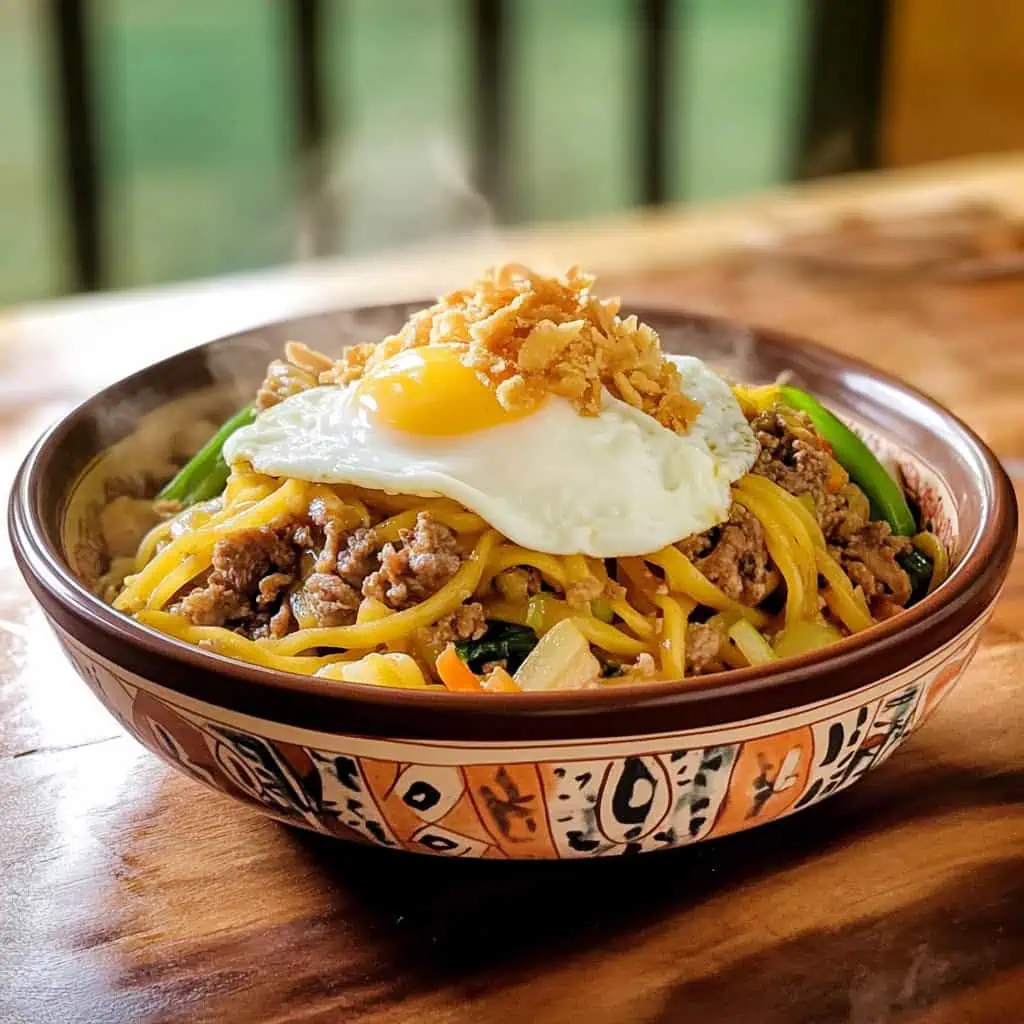





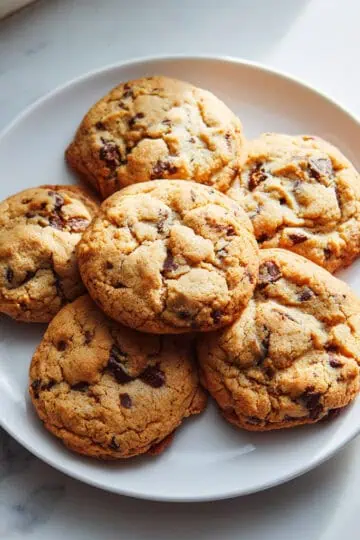
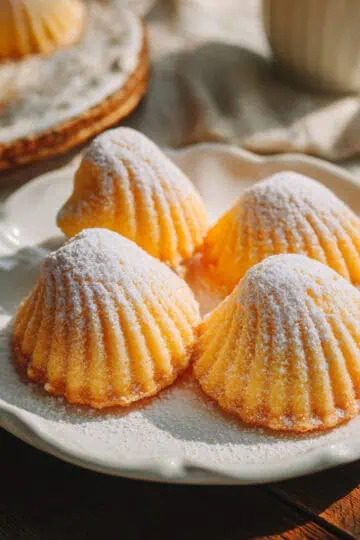
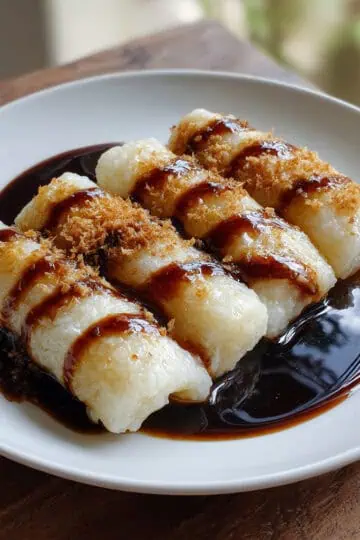
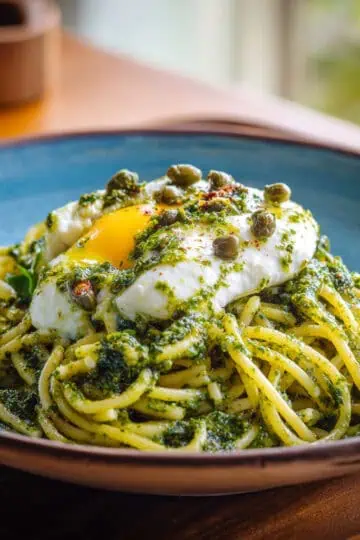
Comments
No Comments